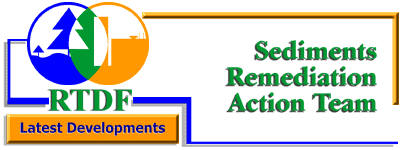|

Contaminated sediments, both in freshwater and marine systems,
are a significant issue in the United States and abroad. Remediation of
sediments is often complex and is usually compounded by the presence of more
than one contaminant at a site. Sediments often contain polycyclic aromatic
hydrocarbons (PAHs) and metals. Many traditional remediation techniques, such
as dredging and subsequent off-site treatment, are not cost-effective, and
proper assessment, which is critical for implementation of a remediation
strategy, also may be difficult and costly.

The mission of the Sediments Remediation Action Team is to
develop cost-effective, on-site technologies to remediate contaminated
sediments and enable recovery of biological systems. The Action Team is
exploring a number of potential focus areas, including:
- Developing in situ remediation approaches
- Evaluating on-site, ex situ remediation technologies
- Examining the applicability of existing soil remediation
techniques to sediments
- Understanding the mechanisms and rates of natural
attenuation
- Enhancing or developing procedures for evaluating the need
for and success of remedial activities

Accomplishments
The Action Team has developed subgroups to focus on the
following three areas of interest:
- Assessment—This area includes the measurement and
evaluation of hazard, stress, and exposure resulting from sediment-associated
contaminants. Information required for the human and ecological risk assessment
paradigms includes (but is not limited to) toxicity, transport, and the ability
of the sediment (biotic and abiotic) to naturally attenuate the
contaminants.
- In Situ Capping—In situ capping as
a remediation alternative involves placement or broadcasting of a covering or
cap of clean isolating material (e.g., sediment, sand, gravel, geotextiles,
etc.) over a deposit of contaminated sediment to isolate it physically and
chemically from the aquatic environment.
- In Situ Treatment—A number of in
situ remediation technologies are under consideration by the subgroup,
including natural attenuation, phytoremediation, introduction of chemical
additives to enhance the natural processes, reactive disposal approaches, and
electrokinetics. The subgroup is most interested in passive technologies that
will remediate the contaminants without significantly increasing the stress on
the ecology.

The efforts of the three subgroups will be coordinated to create
a cohesive research team. The Action Team is identifying sites at which a
cooperative field effort may be pursued. Team members are evaluating the
resources, experience, and facilities they can make available to carry out a
field effort.

For more information about the Sediments Remediation Action
Team, please contact the Team Co-chairs:
Nancy Grosso
DuPont Corporate Remediation
Barley Mill
Plaza - Building 27 (2358)
Wilmington, DE 19880-0027
Tel:
302-992-6783
E-mail: nancy.r.grosso@usa.dupont.com
Dennis Timberlake
U.S. Environmental Protection Agency
National Risk Management Research Laboratory
26 West Martin Luther King
Drive
Cincinnati, OH 45268
Tel: 513-569-7547
E-mail:
timberlake.dennis@epa.gov


Sponsored by the Technology Innovation Program
Date Last Modified:
|


![]()
![]()